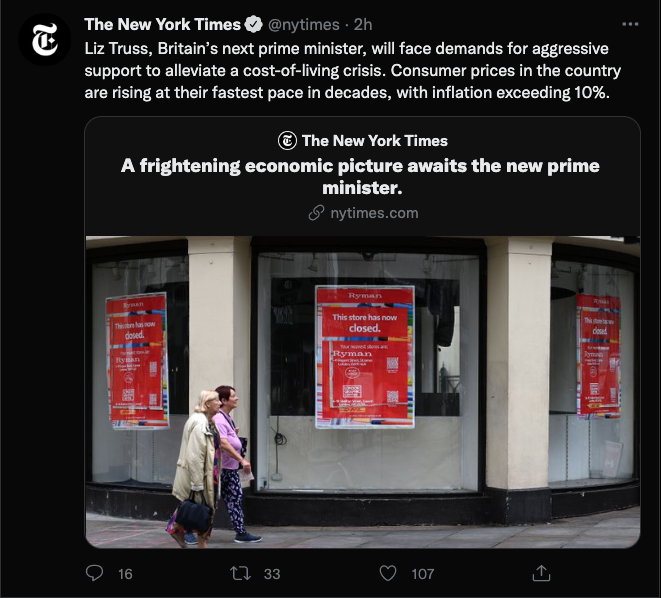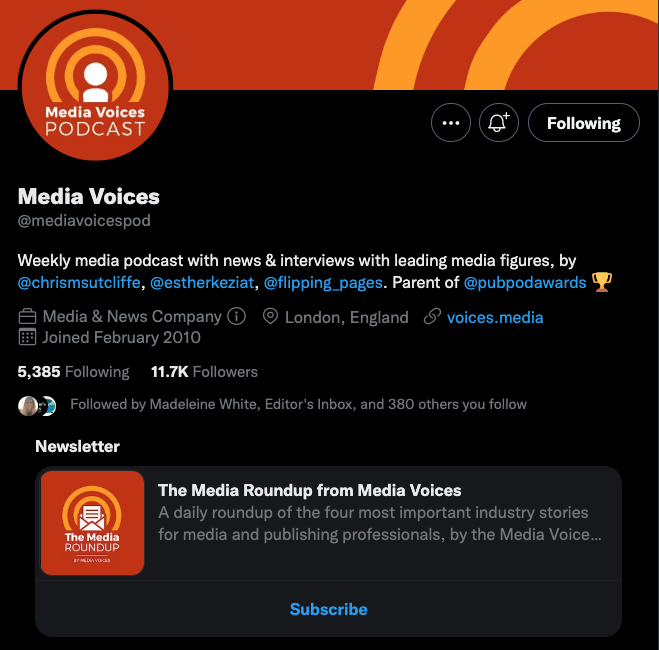
Twitter has long been the social media platform of choice for journalists, and some 77 per cent of journalists value Twitter above all other platforms, according to Muckrack’s State of Journalism 2022 Report.
And the feeling is at least somewhat mutual. The platform has shown it recognises the value of journalists and writers by introducing more and more features aimed at supporting their work.
What sets Twitter apart from other social media platforms, according to Elise Johnson, the New Statesman’s head of audience, is that it has invested in direct relationships with news outlets, unlike Meta-owned Facebook and Instagram.
"The likes of Facebook and Instagram have prioritised money and keeping people on the platform, Twitter has encouraged linking out to other content," says Johnson.
"Breaking news is different on Twitter; they don’t always get it right, but they have responded where Facebook and Instagram haven't."
One example of how this have achieved this is Twitter Moments, a feature that allows news organisations to post a collection of tweets around a given theme or topic for amplified traction and engagement.
"Resharing [on Facebook] just doesn’t have the same velocity. If you were making a bold statement or covering elections in a Moment, the audience is that much more engaged. Things blow up a lot faster."
Johnson says that the platform has also been proactive in working with news organisation to provide best practices for its features when covering major events.
Clone products: hit or miss?
She says that one advantage of Twitter is the way it facilitates interactions between journalists and their audiences, with the chance to access reporters directly through Moments and the now-shelved Fleets (Twitter's answer to Snapchat and Instagram Stories).
Social media features are not always universal in their appeal; the platform and the expectations or habits of its audiences are pivotal. While Fleets did not last long on Twitter, sometimes copies of popular products end up improving the experience or finding a better audience for it. One example is Twitter Spaces, Twitter's take on the Clubhouse app (which has seen a fall in users since its pandemic popularity), which allows users to host live audio conversations.
The New Statesman - along with a few other news organisations - uses Spaces regularly to connect with their audience and provide behind-the-scenes access.
— The New Statesman (@NewStatesman) September 5, 2022
However, the speed and proximity to journalists that is central to the appeal of Spaces and of Twitter itself can make journalists vulnerable, as Johnson explains.
"Women reporters can get torrents of abuse so we have to be careful before hitting publish. It's often very aggressive towards an individual. Twitter needs a bigger team for reporting abuse, that can get to it much faster."
Tile and error
Another feature currently being tested by select news organisations is Tweet Tiles, which promises a more eye-catching look on its embedded links, in the search for clicks and engagement.
The Guardian, New York Times and Wall Street Journal began testing the beta feature in August. It provides new formats for published links with larger images, stand-out fonts and more traditional calls-to-action.

New York Times' Twitter Tiles captured 5 September
While in testing, the new feature can only be seen by iOS and web users but the company said Tiles should improve the performance of a post.
News organisations will be able to create more on-brand posts with tailored typefaces and customisable headlines.
Whether shared by the publisher or retweeted by a user, that branding will follow the piece around the platform, making it easier for users to see its origin and link the content to the brand. It remains to be seen whether the changes are deeper than cosmetic, however.
The write stuff?
Twitter's pivot towards writers centres around a new composer tool called Twitter Write, allowing users to produce longer-form 'Notes' with a character limit of 2,500. That is a huge expansion on the 280-character limit on tweets, which was doubled from 140 in 2017.
Readable both online and offline, Notes offers a ‘write’ tab for storing work and a ‘Notes’ tab on users' profiles where followers can access their writing.
The new addition includes rich formatting and uploaded media, with photos, videos and GIFs all supported. Much like a traditional tweet, they can be sent, shared, liked and bookmarked.
Social media consultant and industry expert Matt Navarra says this is a very different proposition to Facebook’s Instant Articles, a native publishing platform which loads articles faster on Facebook than redirecting to a website.
"This was clearly aimed at news publishers and pushed really hard to get them on the platform. [Twitter Write] feels much more about being for creators, hobbyist or professional writers, but certainly not specifically for a news journalist writing for mainstream publications.
"Creators can potentially gain from distribution and reach and building a community but as a publisher, and as a reader, I'm struggling to see at the moment what is it that would make me be bothered to seek it out."
As Notes stands, the experience is not inherently different to viewing a link in the in-app browser. One of Twitter’s greatest challenges, adds Navarra, is a lack of tools for creators. As the creator economy grows, Twitter has recognised the need to get them on board but is struggling to catch up.
Currently, the feature is only accessible to a select number of writers in trial countries.
Tweet could not be found or could not be loaded.
The feature brings the micro-blogging site in line with macro-blogging mainstays WordPress and Medium.
It also plays into Twitter's increasing moves into the newsletter business, having acquired Dutch newsletter startup Revue last year (which brought the platform under the Twitter Write umbrella). This means that Revue writers can affix a link to their newsletters at the top of their Twitch or Twitter profiles.

Media Voices on Twitter and its Revue newsletter integration
The long-awaited edit button
Twitter is also giving in to popular demand and is testing out its most requested feature: an 'edit tweet' function - but only for those willing to pay $5 a month. It is available initially to Twitter Blue subscribers, limited to users in the US, Canada, Australia, and New Zealand.
Edited tweets will appear with an icon, timestamp and a full edit history of the post’s original versions. This will allow users to correct their typos "a few times" after hitting the tweet button, following long-standing concerns around how original tweets could potentially be manipulated after they have gained traction.
Twitter said: "the time limit and version history play an important role here. They help protect the integrity of the conversation and create a publicly accessible record of what was said."
"Like any new feature, we’re intentionally testing Edit Tweet with a smaller group to help us incorporate feedback while identifying and resolving potential issues. This includes how people might misuse the feature. You can never be too careful."
Tweet could not be found or could not be loaded.
Twitter is also trialling a co-tweet function where a single tweet can be authored by two accounts simultaneously. It marks an opportunity for organisations to leverage the clout of big-name journalists more directly, or for credit to be shared between two collaborating reporters.
Retweet, reshare, rehash
Elsewhere, Twitter has attempted to bring out many more features designed to close the gap between writers and their readers in the form of Communities (like Facebook Groups on Twitter), Super Follows (badges and bonuses for your most loyal followers) and Circles (interacting within small, select groups).
But all of these have become stagnant, says Navarra.
"They all feel a little half-baked, disconnected and disjointed. Whether for writers, creators or everyday users, they don’t seem to know how they are going to join the dots.
"There's a lot of red flags for the platform, the amount of chaos and confusion that seems to be swirling around Twitter, some of it of their own doing, and some of it not."
Twitter’s user base of around 300 million pales in comparison to that of the billions on Instagram and TikTok, explains Navarra, but it still holds its own in terms of how much attention it commands from the newsroom.
Free daily newsletter
If you like our news and feature articles, you can sign up to receive our free daily (Mon-Fri) email newsletter (mobile friendly).
Related articles
- Brian Whelan from Times Radio on growing a successful YouTube news channel
- How journalists can decode 'algospeak' on social media
- Dmitry Shishkin, new CEO of Ringier Media International, on leading growth across 80 media brands
- Rachel Duffy, senior social media editor of The Telegraph, on using Reddit for news
- The Forward removed its paywall and generated 37 per cent more revenue









